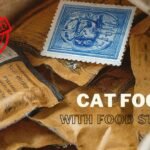Within the enormous world of cat ownership, few ideas are more terrifying than the notion of our cherished feline friends being without food for a while. As pet parents, we work hard to give our feline companions the finest care possible so they can lead happy, healthy lives. But what happens if our cats experience the unimaginable and run out of food and water? The struggle for survival commences as the timer strikes midnight.
Understanding the Basics
Before getting into the dramatic unknown, let’s look at the scientific factors that influence a cat’s capacity to survive hunger and thirst. Cats are well-known for their survival instincts, which reflect their feral predecessors’ ability to navigate tough settings. The domesticated cat has preserved some of these instincts, but can it go for an extended period without food or water?
Food Deprivation
The conventional idea is that a cat can go without food for about 1-2 weeks. However, this is a dangerous tightrope walk that no sensible pet owner should let their feline buddy attempt. Cats are obligate carnivores, which means they need the nutrients present in animal tissues to survive. A prolonged absence of nutrients can result in serious health problems, including hepatic lipidosis, a condition in which the liver begins to collect extra fat.
Hepatic Lipidosis
Dr. Sievert, a famous veterinarian, underlines the dangers of hepatic lipidosis, often known as fatty liver disease, which can occur when a cat loses weight quickly due to food deprivation. The liver, which is unaccustomed to digesting fat efficiently, gets overburdened, resulting in organ failure. This condition emphasizes the significance of feeding our feline pals a well-balanced diet.
Water Deprivation
Although a cat’s fat reserves can keep them going without food for a while, water is a whole other story. Just like all other living things, cats need water to survive. Dehydration can cause renal failure and compromise essential body processes in a matter of days. Pet owners need to make sure their cats always have access to clean water.
The Role of Wet and Dry Food
Although a cat’s fat reserves can keep them going without food for a while, water is a whole other story. Just like all other living things, cats need water to survive. Dehydration can cause renal failure and compromise essential body processes in a matter of days. Pet owners need to make sure their cats always have access to clean water.
Let’s explore the role of wet and dry cat food, highlighting their distinct characteristics and considerations:
Moisture Content
• Wet Cat Food: Generally speaking, wet cat food has a high moisture content between 70 and 80%. This high water content aids in a cat’s overall hydration, which is essential for renal health and avoiding problems with the urinary tract.
• Dry Cat Food: Typically containing between 10 and 12% moisture, dry cat food has a much lower moisture content. Because dry food contains less moisture than wet food, cats cannot naturally drink enough water to make up for this.
Nutrient Density
• Wet Cat Food: The calorie content of wet cat food is often lower than that of dry food. For cats who have special dietary needs or who need to control their weight, this may be helpful. It also makes it possible to regulate portion quantities more precisely.
• Dry Cat Food: Since dry cat food often contains more calories per serving, it is a good option for cats who need to consume more calories. But, as they could eat more calories than necessary, this can pose a problem for cats who are prone to obesity.
Palatability and texture
• Wet Cat Food: Because of its rich scent and meaty texture, wet cat food is more appetizing to many cats. Picky eaters, kittens, and elderly cats who prefer to eat softer food due to potential dental problems may benefit from this.
• Dry Cat Food: Due to its often crispier texture, dry cat food may improve oral health by assisting in the removal of plaque and tartar. Dry kibble may be the preferred texture for certain cats.
Dental Health
• Wet Cat Food: Although it is less abrasive than dry cat food, wet cat food doesn’t offer the same dental advantages. Chewing on crunchy kibble can help clean teeth mechanically, but not chewing it off could cause dental problems.
• Dry Cat Food: Chewing on dry kibble can help a cat’s teeth become free of tartar and plaque, which will improve their dental health. Certain dental diets are designed to precisely treat this.
Shelf Life and Storage
• Wet Cat Food: Compared to dry food, wet cat food has a shorter shelf life once it is opened. To avoid spoiling, it needs to be refrigerated and eaten within a few days.
• Dry Cat Food: This type of food is easier to store and has a longer shelf life. It can be stored in a sealed container to preserve freshness and doesn’t need to be refrigerated.
Cost Considerations
• Wet Cat Food: Compared to dry food, wet cat food is frequently more expensive per calorie. The increased expense can be taken into account by pet owners who are watching their money.
• Dry Cat Food: If a home has several cats or is on a tight budget, dry cat food is usually a more affordable option.
Special Dietary Needs
• Wet Cat Food: There are many different formulations of wet cat food available, including ones tailored for certain medical issues like weight control or urinary tract health.
• Dry Cat Food: Certain health issues, such as hairball control, joint health, or sensitive stomachs, are also catered for in specialized dry cat food.
Hydration Concerns
• Wet Cat Food: It’s important to make sure your cat is getting enough water, especially if they eat mostly wet food. It’s important to give fresh water to cats because some of them might not drink enough on their own.
• Dry Cat Food: Cats that are given only dry food may not get enough moisture in their diet, which could result in dehydration. It’s critical to promote water intake by offering hygienic, conveniently located water sources.
Health Implications and Veterinary Attention
Long-term deprivation of food and drink can lead to several health problems, including weight loss, impaired immune systems, and organ failure. Veterinary care is essential in these circumstances. Veterinarians can stabilize a cat’s condition by giving it the required fluids and nutrition; thus, prompt intervention can be the difference between life and death.
Nutritional Needs and Balanced Diets
A balanced diet that provides for a cat’s nutritional demands is essential to its overall health. For pet owners, ingredient analysis becomes crucial to ensuring that the selected cat food has the necessary nutrients. A healthy cat is better able to handle unforeseen obstacles and stay in good condition.
The Emotional Toll on Pet Owners
The thought of our feline companions going through such pain can be emotionally overpowering for pet lovers. The obligation to provide proper care and attention to our cats becomes a religious duty, requiring us to take proactive actions to avoid any potential pain.
Additional Considerations
Dry Food and Dental Health
The distinction between wet and dry foods goes beyond hydration problems. Dry cat food is frequently advertised as having dental benefits, such as reducing plaque and tartar. However, feeding only dry food may not supply enough moisture, necessitating careful consideration of a cat’s general health.
Senior Cats and Specialized Diets
Senior cats and those with health problems may require specific diets. Consulting with a veterinarian to address specific dietary needs, particularly in elderly cats prone to renal disease, is critical for maintaining good health.
Behavioural Changes and Stress
Extended periods without food or water can cause severe behavioral changes in cats. Stress, anxiety, and depression may develop, worsening the rehabilitation process. Recognizing these symptoms early on and addressing the underlying reason is critical for a comprehensive approach to a cat’s health.
Conclusion
In the world of pet ownership, the topic of how long a cat can go without food and water is a chilling one that no pet parent should overlook. The affection and responsibility we feel for our feline companions compels us to prioritize their well-being, ensuring they never go hungry or thirsty. With careful care, attention to nutritional needs, and prompt veterinarian intervention when needed, we can protect our cats from the shadows of protracted deprivation and guarantee they enjoy long, healthy lives by our side.







